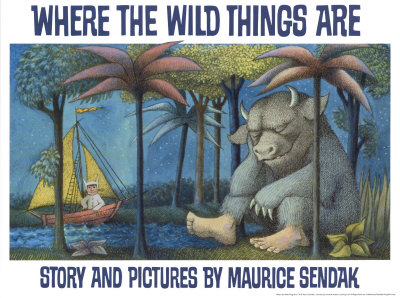
THE THREE PIGS
BIBLIOGRAPHY
Wiesner, David, 2001. THE THREE PIGS. New York, NY: Houghton Mifflin Company. ISBN: 0618007016
PLOT SUMMARY
This tale begins familiarly with "Once upon a time there were three pigs." The first pig decided to build a house out of straw and then along came the wolf who said "little pig, little pig, let me come in." And the pig answered, 'not by the hair of my chinny-chin-chin." Then the wolf "huffed and he puffed and he blew the house in..." But wait! The wolf blew so hard, he blew the pig right out of the story! The story continues with the wolf going to the next pig's house made out of sticks. The same thing happens and now two pigs are out on an adventure of their own. On the next page, they join the third pig and then they completely turn the story upside down (literally)! They all three totally exit the book and the illustrations show them walking on the pages of the book. They have text bubbles that show what they are saying. Then they build a paper airplane out of one of the pages of the book and go on a flying expedition through several more pages of the story. On one page, they almost completely fly out of the book (or so it seems!). Then their adventure takes them into other stories. They visit a Mother Goose book and meet the cat and the fiddle and the cow who jumped over the moon. Then they meet a dragon. The cat and the fiddle and the dragon join them when they rejoin their own story and "go back home." In the end, nobody gets eaten and "they all lived happily ever aft." (guess the "er" fell off the page too!)

CRITICAL ANALYSIS
This fractured fairy tale is hilarious! Wiesner uses such creativity and what a surprise this will be to the young readers when they see the first pig blown "out of the story" and the perplexed look on the wolf's face! I love how he incorporated other tales that the young readers would know as well, such as the cat and the fiddle and the cow who jumped over the moon. This is a very creative spoof of the original story. It is a very visual book and the illustrations tell the story for several pages. Wiesner uses dialogue balloons to tell part of the story. The looks on the wolf's face are priceless! He is so confused. By the end, I think that he just gives up although we don't really know what happened to him. And as in all fairy tales, there was a happy ending!
AWARDS
Caldecott Medal 2002
REVIEW EXCERPTS
PUBLISHER'S WEEKLY:
"Wiesner's brilliant use of white space and perspective (as the pigs fly to the upper right-hand corner of a spread on their makeshift plane, or as one pig's snout dominates a full page) evokes a feeling that the characters can navigate endless possibilities--and that the range of story itself is limitless."
SCHOOL LIBRARY JOURNAL, Starred:
"Children will delight in the changing perspectives...and the whole notion of the interrupted narrative...fresh and funny...Witty dialogue and physical comedy abound in this inspired retelling of a familiar favorite."
BOOKLIST, ALA Starred Review:
Wiesner has created a funny, wildly imaginative tale that encourages readers to leap beyond the familiar; to think critically about conventional stories and illustration, and perhaps, to flex their imaginations and create wonderfully subversive versions of their own stories."
CONNECTIONS
This imaginative story provides opportunities for predicting outcomes and retellings and prompting creative writing.
This book will also make a great companion to other fractured fairy tales, Jon Scieszka's "The True Story of the Three Little Pigs" and the seriously silly book, ECO-WOLF AND THE THREE PIGS.
This story could even be presented as a Reader's Theatre. I think that there are many different ways that a teacher can incorporate these varied stories within a lesson.



